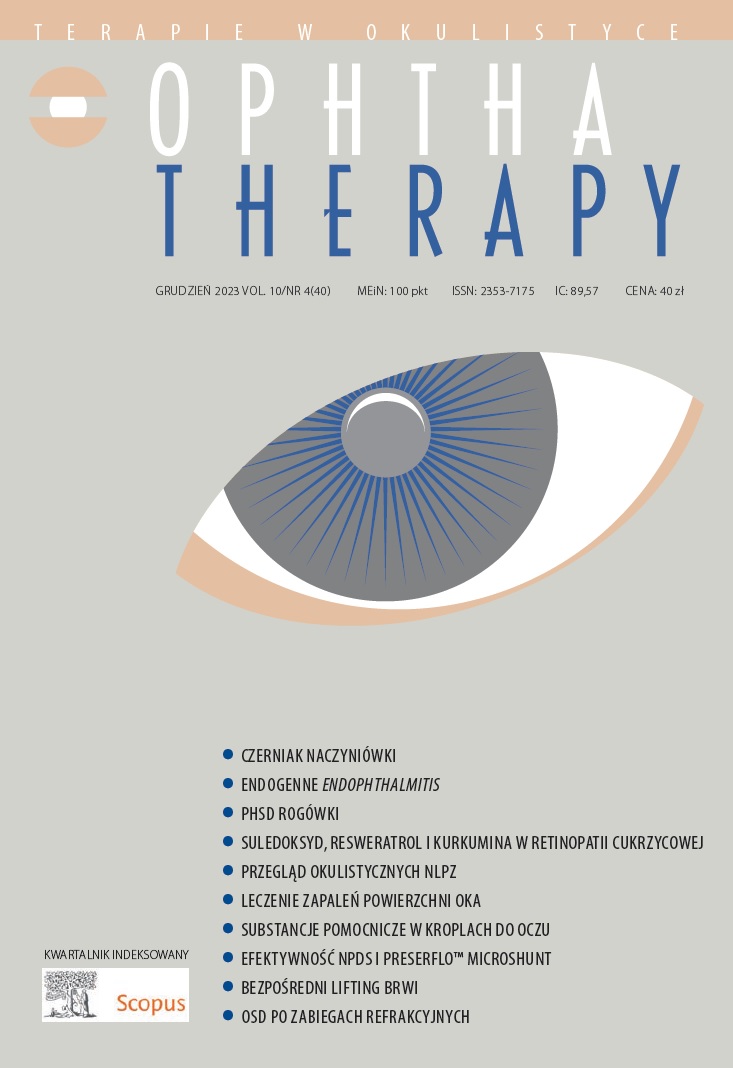Comparison of drugs belonging to the group of ophthalmic non-steroidal anti-inflammatory drugs Review article
Main Article Content
Abstract
Ophthalmic non-steroidal anti-inflammatory drugs are non-steroidal anti-inflammatory drugs used to treat or prevent eye inflammation. Their main action is to relieve symptoms such as pain, redness and swelling that can be caused by eye diseases, injuries or eye surgery. Non-steroidal anti-inflammatory drugs used in ophthalmology include substances such as diclofenac, ketorolac, bromfenac and nepafenac. So far, many studies have been published comparing the effectiveness of various systemic and local non-steroidal anti-inflammatory drugs. This work contains a comparative analysis of the above-mentioned substances in terms of their use and effectiveness in ophthalmology.
Downloads
Article Details

This work is licensed under a Creative Commons Attribution-NonCommercial-NoDerivatives 4.0 International License.
Copyright: © Medical Education sp. z o.o. License allowing third parties to copy and redistribute the material in any medium or format and to remix, transform, and build upon the material, provided the original work is properly cited and states its license.
Address reprint requests to: Medical Education, Marcin Kuźma (marcin.kuzma@mededu.pl)
References
2. Wilson DJ, Schutte SM, Abel SR. Comparing the efficacy of ophthalmic NSAIDs in common indications: A literature review to support cost-effective prescribing: A literature review to support cost-effective prescribing. Ann Pharmacother. 2015; 49(6): 727-34. http://doi.org/10.1177/1060028015574593.
3. Kim JM, Shakir O, Adelman RA. A comparison of ketorolac, diclofenac, nevanac, flurbiprofen, and bromfenac in the treatment of cystoid macular edema: a retrospective analysis. Invest Ophthalmol Vis Sci. 2017; 58(8): 4634.
4. Flaxel C, Schain MB, Hamon SC et al. Prospective randomized controlled trial of combination ranibizumab (Lucentis) and bromfenac (Xibrom) for neovascular age-related macular degeneration: a pilot study: A pilot study. Retina. 2012; 32(3): 417-23. http://doi.org/10.1097/IAE.0b013e318229b0af.
5. Gomi F, Sawa M, Tsujikawa M et al. Topical bromfenac as an adjunctive treatment with intravitreal ranibizumab for exudative age-related macular degeneration. Retina. 2012; 32(9): 1804-10. http://doi.org/10.1097/IAE.0b013e31825be87f.
6. Donnenfeld ED, Holland EJ, Stewart RH et al. Bromfenac Ophthalmic Solution 0.09% (Xibrom) Study Group. Bromfenac ophthalmic solution 0.09% (Xibrom) for postoperative ocular pain and inflammation. Ophthalmology. 2007; 114(9): 1653-62. http://doi.org/10.1016/j.ophtha.2006.12.029.
7. Lane SS, Modi SS, Lehmann RP et al. Nepafenac ophthalmic suspension 0.1% for the prevention and treatment of ocular inflammation associated with cataract surgery. J Cataract Refract Surg. 2007; 33(1): 53-8. http://doi.org/10.1016/j.jcrs.2006.08.043.
8. Achiron A, Karmona L, Mimouni M et al. Comparison of the tolerability of diclofenac and nepafenac. J Ocul Pharmacol Ther. 2016; 32(9): 601-5. http://doi.org/10.1089/jop.2016.0057.
9. Szucs PA, Nashed AH, Allegra JR et al. Safety and efficacy of diclofenac ophthalmic solution in the treatment of corneal abrasions. Ann Emerg Med. 2000; 35(2): 131-7. http://doi.org/10.1016/s0196-0644(00)70132-6.
10. Gaynes BI, Fiscella R. Topical nonsteroidal anti-inflammatory drugs for ophthalmic use: A safety review. Drug Saf. 2002; 25(4): 233-50. http://doi.org/10.2165/00002018-200225040-00002.
11. Giannaccare G, Finzi A, Sebastiani S et al. The comparative efficacy and tolerability of diclofenac 0.1% and bromfenac 0.09% ophthalmic solutions after cataract surgery. Curr Eye Res. 2018; 43(12): 1445-53. http://doi.org/10.1080/02713683.2018.1501489.
12. Colin J, Paquette B. Comparison of the analgesic efficacy and safety of nepafenac ophthalmic suspension compared with diclofenac ophthalmic solution for ocular pain and photophobia after excimer laser surgery: a phase II, randomized, double-masked trial. Clin Ther. 2006; 28(4): 527-36. http://doi.org/10.1016/j.clinthera.2006.04.004.
13. Russo A, Costagliola C, Delcassi L et al. Topical nonsteroidal anti-inflammatory drugs for macular edema. Mediators Inflamm. 2013; 2013: 476525. http://doi.org/10.1155/2013/476525.
14. Zhao X, Xia S, Wang E et al. Comparison of the efficacy and patients’ tolerability of Nepafenac and Ketorolac in the treatment of ocular inflammation following cataract surgery: A meta-analysis of randomized controlled trials. PLoS One. 2017; 12(3): e0173254. http://doi.org/10.1371/journal.pone.0173254.
15. Mohammadpour M, Heidari Z, Molani R. Comparison between diclofenac and ketorolac ophthalmic drops for pain management after photorefractive keratectomy: A randomized clinical study: A randomized clinical study. Eye Contact Lens. 2019; 45(2): 137-40. http://doi.org/10.1097/ICL.0000000000000524.
16. Donnenfeld ED, Holland EJ, Durrie DS et al. Double-masked study of the effects of nepafenac 0.1% and ketorolac 0.4% on corneal epithelial wound healing and pain after photorefractive keratectomy. Adv Ther. 2007; 24(4): 852-62. http://doi.org/10.1007/bf02849978.
17. Trattler W, McDonald M. Double-masked comparison of ketorolac tromethamine 0.4% versus nepafenac sodium 0.1% for postoperative healing rates and pain control in eyes undergoing surface ablation. Cornea. 2007; 26(6): 665-9. http://doi.org/10.1097/ICO.0b013e31805290ce.
18. Vetrugno M, Maineo A, Quaranta GM et al. A randomized, double-masked, clinical study of the efficacy of four nonsteroidal anti-inflammatory drugs in pain control after excimer laser photorefractive keratectomy. Clin Ther. 2000; 22(6): 719-31. http://doi.org/10.1016/s0149-2918(00)90006-7.
19. Rajpal RK, Ross B, Rajpal S et al. Bromfenac ophthalmic solution for the treatment of postoperative ocular pain and inflammation: safety, efficacy, and patient adherence. Patient Prefer Adherence. 2014; 925. http://doi.org/10.2147/ppa.s46667.
20. Walters TR, Goldberg DF, Peace JH et al. Bromfenac Ophthalmic Solution 0.07% Once Daily Study Group. Bromfenac ophthalmic solution 0.07% dosed once daily for cataract surgery: results of 2 randomized controlled trials. Ophthalmology. 2014; 121(1): 25-33. http://doi.org/10.1016/j.ophtha.2013.07.006.
21. Silverstein SM. Bromfenac Ophthalmic Solution 0.07% Versus Nepafenac Ophthalmic Suspension 0.3% for Post-Cataract Surgery Inflammation: A Pilot Study of Identical Dosing Regimens with Pre-Surgical “Pulse” Dose. Ophthalmol Ther. 2019; 8(4): 577-87. http://doi.org/10.1007/s40123-019-00215-y.
22. Chinchurreta Capote AM, Lorenzo Soto M, Rivas Ruiz F et al. Comparative study of the efficacy and safety of bromfenac, nepafenac and diclofenac sodium for the prevention of cystoid macular edema after phacoemulsification. Int J Ophthalmol. 2018; 11(7): 1210-6. http://doi.org/10.18240/ijo.2018.07.22.
23. Modi SS, Lehmann RP, Walters TR et al. Once-daily nepafenac ophthalmic suspension 0.3% to prevent and treat ocular inflammation and pain after cataract surgery: phase 3 study. J Cataract Refract Surg. 2014; 40(2): 203-11. http://doi.org/10.1016/j.jcrs.2013.07.042.
24. Cagini C, Pellegrino A, Cerquaglia A et al. Comparison of the effect of diclofenac 0.1% and nepafenac 0.1% on aqueous flare in patients undergoing cataract surgery: A prospective randomized study. Curr Eye Res. 2020; 45(9): 1089-93. http://doi.org/10.1080/02713683. 2020.1725061.
25. Kim S, Schoenberger S. Zastosowanie niesteroidowych leków przeciwzapalnych w chorobach siatkówki. Okulistyka po Dyplomie. 2013; 3(2): 46-55.
26. Alnagdy A, Eissa AM, El-Kannishy A. Topical NSAIDs in Prevention of Postcataract Macular Edema. Frontiers in Ophthalmology and Ocular Imaging. 2019. http://doi.org/10.5772/intechopen.82321.
27. Medycyna Praktyczna.
28. Wielka Baza ChPL.

